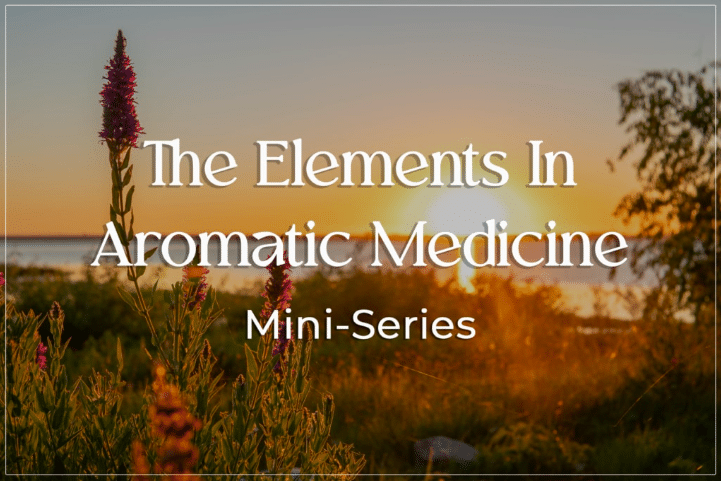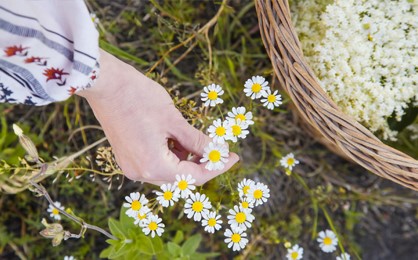
Have you ever wondered why exactly it is, that an aromatic remedy may work great for you, but not for your neighbor?
This is because every person is incredibly unique, and so is every plant. Two people could use the same plant and have a different response, because plants, like people, have distinct personalities and energetics – each one of us will connect in a different way with all botanical beings.
My teacher, Dr. Vasant Lad often says, “Every individual is indivisible!”
Through studying, I am finding this statement truer each day. Plants are living, conscious beings, and how we relate to them will depend on the energetic makeup present within us. The qualities of plants can be revealed through taste, morphology, actions or bodily affinities, the environment in which they grow, color, and smell. In a person, there are many ways to observe qualities, through questioning, sight and touch (ie. the pulse). It is important to observe the whole person and the whole plant in order to fully understand what kind of relationship may unfold between them.

The Doshas
Ayurveda is an ancient Indian health-science that observes the world through qualities and elements, for example – heavy, light, cold, hot, liquid, dense, oily, dry, smooth, rough, etc. – and everything in physical existence has a specific qualitative expression.
Each person and plant has a unique constitution. In Ayurveda, a person’s genetic blueprint is called “Prakruti” which is determined at the moment of conception. Prakruti refers to the dominant expressions of qualities naturally occuring within a person. These expressions are categorized into three bodily humors, called “Doshas.” The three doshas are called Vata, Pitta and Kapha and are present in every cell.
Each dosha is a manifestation of a combination of elements. Vata is the principle of movement, is composed of ether and air, and is light, dry, rough, mobile and cold in quality. Pitta is a combination of fire and water, and is the ultimate governor of intellect, digestion, transformation and perception. It is hot, sharp, oily, light, fleshy smelling, liquid and spreading. Kapha is the concept of physicality and structure. It is a manifestation of water and earth elements, and is heavy, slow, smooth, oily, dense, and gross in quality. In every person, we can see a different variation of these three qualities, often with one expressing more predominantly than others
For example, a person who is pitta predominant may have a lot of heat in their body, are more likely to have freckles, have sharp hunger, quick digestion and be bright, brilliant and focused. Due to the hot and sharp qualities, a pitta predominant person may also become easily frustrated or angry. A vata predominant person may have a thin frame, be active and creative.
Due to vata’s qualities, such as dry, rough and mobile – a person predominantly vata may tend towards dryness, constipation or anxiety. A vata person might also tend toward weaker joints, structural discomfort or pain, and have difficulty concentrating, or experience spaciness or forgetfulness. A kapha person may have round facial features, smooth, oily skin and hair, a full frame and have a slow, deeper melodious voice. Due to the heavy, slow qualities of kapha, these individuals may have a tendency towards melancholy or sedentary lifestyles.
Throughout our life, with the foods we eat, the lifestyle choices we make, and environments we are exposed to, our body naturally shifts. Daily life experience is where imbalance can occur and create dis-ease. Whatever symptoms show up in us, also have a specific set of qualities.
Plant Energetics
Similar to people, plants also have a prakruti, and each one’s morphology, taste, color, scent, and texture can reveal what effects it will have on a person's body. Some plants are warming, cooling, drying or moistening, and tense (astringent) or relaxing. For example, Ginger is energetically warming due to its ability to stimulate blood flow, Licorice is cooling and moistening as a demulcent, and Yarrow is energetically tense and can have a tonifying effect on tissues due to its astringent properties.
When it comes to working with plants, remember that like-increases-like; so plants that are similar in quality to the quality of the symptoms showing in us can be aggravating. Plants that are opposite in quality to the symptoms expressing within us can be relieving.
For example, if you had acid reflux due to excess heat in the body, you may want to reach for Aloe Vera, which has a cooling effect, rather than a spicy-hot Cayenne pepper to ease the symptoms.
Though this is not always a hard-and-fast rule, for simplicity’s sake, we will focus on balancing with energetic opposites in this article. Let's take a look at a few different aromatic plant examples to have a clearer idea of this topic. The information will be generalized, and like I said earlier, everyone will respond differently to each plant, so the best way to find out if a plant is truly helpful for you, is to connect with it and see!
Unlock Your Free Issue Of...
🌿 The Aromatic Medicine Garden Membership 🌿
Are you ready for a deeper, holistic dive into the world of aromatic plants? See what our membership is all about with your free sneak peek issue, including an hour-long plant talk and a 21-page plant monograph pdf full of recipes.

Sage
Sage is pungent, bitter, astringent and heating in quality, and can also have a drying effect. That being said, if you have symptoms such as a cough with expectoration or swollen lymph nodes, Sage can be very helpful. But if there is excess heat or dryness in your symptoms, such as a dry cough, Sage could be aggravating.
Sandalwood
Sandalwood is an amazing aromatic plant which has a cooling effect on the mind and body. It has an affinity for the nervous, reproductive and circulatory systems [1]. Because Sandalwood is bitter, cooling and astringent in quality, it can have an amazing effect on various heat-related issues such as cystitis, dermatitis, and bronchitis [1]. But if there is excess damp, cold Kapha qualities such as severe lung congestion, Sandalwood may not be the remedy to reach for.

Jasmine
Jasmine flowers are particularly calming. They are bitter, astringent and pungent, but can have a cooling effect. Jasmine can be used for headaches, skin conditions such as dermatitis or sunstroke, and be helpful in strengthening the lymphatic system [1]. Jasmine has traditionally also been paired with Sandalwood, and in Ayurveda, is said to awaken love, compassion, psychic qualities and expand the state of the mind.
However, because of the light, dry, cool qualities of Jasmine flowers, someone who also is expressing these qualities within their body might not find Jasmine beneficial.
Lotus
Lotus has a calming, cooling, stabilizing quality for the mind and body. When used aromatically, it can ease the mobile, rough qualities that can unfold when our minds become busy. The roots used medicinally tend to work on things such as diarrhea, hemorrhoids and supporting the uterus [1]. The seeds tend to be more of a cardiac tonic and have a way of opening the heart – like a bright, beautiful, brilliant Lotus flower!
Ayurveda relates Lotus to Lakshmi, the goddess of abundance, and is said to help with devotion and spiritual growth [1]. Lotus relaxes the mind and can bring pleasant dreams. Due to the heavy, stable, cooling quality of Lotus, it may be a miracle plant for some, but those with enough of the stable, heavy qualities in their mind or body may not find Lotus as helpful.
Holy Basil
Holy Basil, also known as Tulsi, is an amazing aromatic plant for many reasons. It can help support digestion, improve absorption, enhance memory, and is great as tea for dehydration [1]. Ayurveda considers Tulsi to be especially supportive to the plasma and blood, but also has an affinity for the nervous, respiratory and digestive systems [1]. It can help to ease headaches and sinus congestion, coughs, or pain in the body. Holy Basil is sacred in India and is said to expand the heart and mind and unfold clarity, love and compassion within a person. Holy Basil is pungent and heating in quality and action, so a person with excess heat in the body may not find this plant as useful if taken internally.
The Healing Journey
When working with the botanical kingdom, it is important to observe, without judgment, the subtle energetics behind both the person and the plant. If you are able to clearly understand the underlying qualities present within someone, and how they correspond to a certain plant, you can become far more efficient with your remedial selections.
This is just something to keep within your awareness when deciding on which aromatic plants to reach for. Spending time with plants, meditating on their qualities, and perceiving their subtle characteristics will be the ultimate way to truly realize their entire being.
The journey of understanding how both plants and the body functions is ever-evolving and life-long. But by looking at the world through the lens of energetic qualities, we can strengthen our intuition and unfold an entirely new level of perception about how nature creates and expresses itself. Along the way, you will start to see that everything in nature is reflected within you.

Are you ready to uncover your personal constitution and explore its deep connection to aromatic medicine and the Elements? Dive into the timeless wisdom of the Elements with our Foundational Mini-Course Bundle—a transformative journey into holistic aromatic healing. This exclusive bundle includes two enriching courses: The Elements in Aromatic Medicine and Personal Constitution & Aromatic Medicine. Together, they offer a profound exploration of the Elements, Humoral Theory, and Temperaments, helping you align plant-based remedies with your unique needs.
Discover how to harness nature’s elemental forces for balance, well-being, and personal growth. With this one-of-a-kind bundle, you’ll gain lifelong insights into the art and science of aromatic medicine.
Article Written By Dawn Gibson

References
1. Lad, V. & Frawley D. (1986). The Yoga of Herbs: An Ayurvedic Guide to Herbal Medicine.
© 2022 The Northwest School of Aromatic Medicine. All rights reserved.
*The statements above have not been evaluated by the FDA, and are for educational purposes only. This article is not intended to diagnose, treat, cure, or prevent any disease. This article should not be taken as medical advice. Please consult your physician before you use this information for health purposes.
